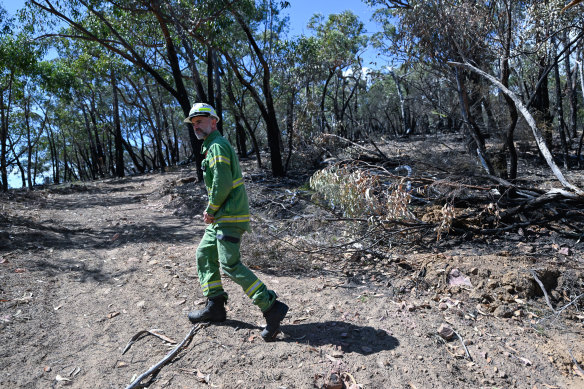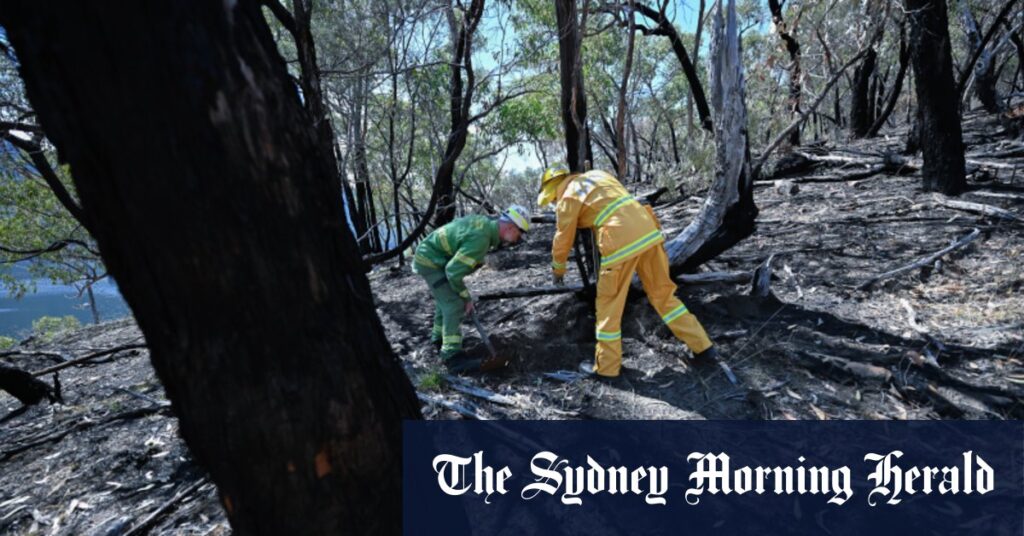Enter the heart of Halls Gap right now, and you would struggle to see any sign that the town of 450 people recently came within 200 metres of catastrophe.
It’s beautiful and serene. The craggy peaks of the Grampians soar dramatically over either side of the town, their rugged slopes covered in dusky green eucalyptus forest.
An abundance of kangaroos and emus graze in the grassy clearings between holiday houses and hotels. Screeching sulphur-crested cockatoos engage in turf wars with magpies in the trees.
Maybe it’s a bit too serene.
It’s a warm, sunny day in early January – the peak holiday season for this tourist town – and the place is eerily empty. At times, there are more ducks than cars on the main road.
Stawell resident Harland Henderson, his son, Rick, and Rick’s 14-year-old son, Riley, have set up their small caravan under a shady tree in the local caravan park, continuing a family tradition of three generations holidaying together in Halls Gap.
Harland raced down on Wednesday morning, when the town was reopened to the public, after being evacuated on December 20. He needn’t have worried about missing a prime spot. Save for a solitary camper who has pitched his tent 100 metres away, they have the park to themselves.
“I’ve been coming to Halls Gap for years, and I’ve never seen it like this. It’s the quietest I’ve ever seen it in my whole life,” Harland says.
Firefighters worked for three weeks to contain the Grampians fire. Credit: Justin McManus
Ordinarily, the park would be at or near capacity between Boxing Day and Australia Day, but the Grampians region has just endured its largest bushfire in almost 20 years, and its second major fire in less than 12 months.
Sparked by dry lightning, the fire burnt through more than 76,000 hectares of national park and farmland. The Country Fire Authority says it destroyed four homes in Moyston and Mafeking, 40 outbuildings, claimed 1285 beehives, killed 775 sheep, a horse and a beef cow. The toll on native flora and fauna is unknown.
It started in a remote and inaccessible part of the national park and eventually spread over a vast area of more than 440 kilometres, burning for three weeks before firefighters contained it. Halls Gap was reopened to the public on January 8.
The Grampians (Gariwerd) National Park was officially reopened two days later on January 10, though much of its southern section remains off-limits as the fire continues to smoulder there. Falling trees burning from the inside out also present a hazard, and many of the walking trails have been damaged.
Where last February’s fire ripped through the small town of Pomonal in a day, this fire was more of a slow burn, what firefighters call a “campaign fire”.
Halls Gap resident Jono Almond is an operations officer with Forest Fire Management Victoria, and was part of an army of hundreds of firefighters who worked to contain the fire over a 21-day campaign. The firefight took them within 200 metres of the closest homes in Bellfield, a tiny hamlet at the southern tip of the Halls Gap township.

Forest Fire Management Victoria operations officer Jonathon Almond surveys the fire ground near Bellfield, on the edge of Halls Gap.Credit: Joe Armao
Almond said the dry vegetation and the steep terrain had helped the fire to spread quickly and made it difficult for firefighters to reach it. Bulldozers and even fixed-wing aircraft struggled to reach the fire. Helicopters had more success.
“We had the weather on our side, but the fuel and terrain was against us,” he says. “Then we had a couple of – we call them blow-up days – significant weather days where the fire made major runs across our landscape, which then started to impact on private assets and critical infrastructure.”
The Gariwerd landscape is 440 million years old. It has burnt before and will burn again. Fire is an essential part of its ecology. But fires are also happening with increasing frequency, Almond says.
“South-eastern Australia is a fire-prone area, and we just need to understand that it’s happening more often than what we remember in recorded fire history,” he says. “In the last 20 years here in Gariwerd, we’ve seen a definite increase in fire activity in this landscape.”
Justine Hide has lived in Halls Gap for 10 years, runs a small tourism business and is deputy mayor of the Northern Grampians Shire.
Loading
She recalls getting the notice to evacuate at 10pm days before Christmas, as fire approached from the south, loading the car with “two kids, two dogs, a cat, two guinea pigs” and hitting the only road out of town.
“We were driving out about 11pm and so was everybody else. It was like this mass exodus in the dark, in thick smoke, people that shouldn’t be driving at night, elderly people, you could just tell they shouldn’t be on the road, or people weren’t coping. It was really scary, to be honest.”
Later, Hide spoke with an elderly man who drove to Lake Fyans and slept in his car, facing the fire so he would wake up if it came in his direction.
“Some people had nowhere to go,” she says.
The Pomonal fire destroyed 45 homes and cost the local economy an estimated $202 million, Grampians Tourism chief executive Marc Sleeman says.
Though it is too soon to estimate the cost of this fire, Sleeman predicts it will be similarly harmful to the local economy, which relies heavily on tourism.
“In February, up to 2500 jobs were impacted; 460,000 visitors didn’t come to our region because of the fires in February. The number is going to be up in the millions because of this fire, and the economic impact will be long-term.”
Cherie Smith owns an ice-creamery and a gift shop in Halls Gap and says the town’s closure coincided with the biggest trading period of the year.
“Boxing Day is usually our huge day here for our ice-creamery. Just in one day, we probably lost over $10,000 in ice-creams,” she says.
“But we’re here, that’s the main thing. We can reopen, you’ve got to look at it in a positive way.”
She hopes those who cancelled their summer bookings return on the Australia Day weekend or at Easter.
“The accommodation places would be horrendously down,” she says.
The community has also chipped in to help one of the area’s biggest drawcards, the privately owned Halls Gap Zoo. The zoo faces heavy losses after being forced to close its doors during what should be its most profitable time of year.
“January covers months like February when we actually lose money,” zoo owner Mark Treweek says.
Halls Gap Zoo owner Mark Treweek with one of the zoo’s biggest attractions, the red panda.Credit: Joe Armao
Treweek evacuated those animals that could be transported to Werribee Zoo and Ballarat Wildlife Park, took some home to his garage, then made daily visits to the zoo to feed and water the animals that remained for the evacuation period.
He also set up a GoFundMe page, which has received more than $90,000 in donations.
“It’s not something that I ever like doing or want to do, ask for money from donations,” he says.
“Personally, it’s the only thing that’s affected me during the whole fire. Bushfire, OK, I can’t stop it. People being nice to you and donating $90,000, that’s the only thing that’s brought a tear to my eye.”
The Allan government’s new minister for small business, Natalie Suleyman, toured Halls Gap on the day the town reopened and met with affected business owners.
Visitors are returning to the Grampians National Park and Halls Gap.Credit: Joe Armao
A government spokesperson said there were both Commonwealth and Victorian government-funded financial support services available, including up to 13 weeks of income support for workers and sole traders who had experienced loss of income.
But Hide criticises the support package, arguing it leaves most small business owners out in the cold.
She also says the government must reckon with the worsening affordability of insurance for a community that is experiencing fires more often due to climate change.
The cost of insurance for her own small business doubled after the Pomonal fire. She knows of another local business whose insurance bill rose from $1900 to $9500.
“Insurance is out of control,” she says. “We’re in a fire-prone area. No one can get fire coverage. If it burns down, you’ve lost your million-dollar house, or your $10 million business.”
The northern section of Grampians National Park is reopened to tourists after a three-week closure.Credit: Joe Armao
It was an unceremonious moment when the national park, one of Victoria’s natural wonders, was reopened on Friday. A young traffic management worker collected the “Road Closed” sign from where it stood blocking Mt Victory Road, and put it in the back of her ute.
It was 9.25am, slightly later than the scheduled 9am opening time.
Vance Wheeler sat across the road, alone in his car, waiting for the moment when he could drive up the winding mountain road.
Wheeler travelled from Wodonga, in the state’s north-east, to volunteer with BlazeAid. In two days, he would begin his volunteer work, helping farmers to reconstruct hundreds of kilometres of damaged and destroyed fences.
Wheeler saw farmers in his own community in the upper Murray region who “basically lost everything” in the Black Summer fires of 2019-20 and says the volunteer movement of fence-builders provides powerful practical and moral support.
“People being nice to you and donating $90,000, that’s the only thing that’s brought a tear to my eye.”
Mark Treweek
“It doesn’t fix all of their problems by any means, but it just gives a start to an insurmountable problem and it also says there’s some people on your team.”
Loading
But first he planned to spend the day being a tourist, enjoying the environment and buying a meal and a coffee in Halls Gap.
“I guess put some money into the town but also just let people here know they’ve been through a tough period. Sure, the town hasn’t been burned out, but the town’s been affected … As soon as there’s a bushfire, every accommodation place just gets cancellation after cancellation.”
The impact of a significant bushfire lasts for years, he says.
“It has a really big impact on the town, financially but also just emotionally.”
The Morning Edition newsletter is our guide to the day’s most important and interesting stories, analysis and insights. Sign up here.
Read the full article here


